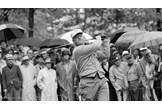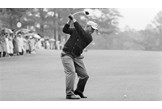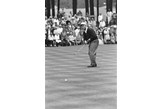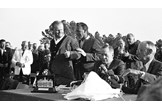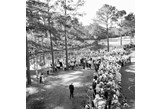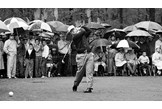Interview: Jack Nicklaus
Published: Last updated:
Fifty years ago, Jack Nicklaus was 23; and when he arrived at Augusta, no-one younger had won a Green Jacket…
In Wednesday’s final practice round, the weather was perfect. By the first tee time on Thursday morning there was a gale blowing – one of the windiest days, some Masters veterans said, in the tournament’s history. After 13 holes, I found myself three over par.
What with the wind speed and the dried-out greens, I had plenty of company. But I was still a little surprised, because I had struck the ball well. The right-to-left pattern was holding up well, and although I’d got a couple of bad bounces and missed some makeable putts, I was playing pretty tight golf. And yet, there was a long way to go. I decided to hang cool and keep on trucking.
The reward came immediately with the day’s first birdie at the 14th hole, followed by another at the par-5 15th and a great little chip at 16 to save my three. I slipped to another bogey at 17, but parred the final hole for a round of 74. I would have liked it better, but no-one had run away and hidden. Mike Souchak and Bo Wininger shared the lead at 69, with most of the scores in the mid to high 70s.
Friday, typically, was perfect again – warm and sunny with the lightest of breezes. I missed the green at the 1st with a wedge, but made par and never missed another putting surface all day until number 18, where I chipped dead from the fringe.
From the 2nd through the 6th holes all my first putts were for birdies, and they all looked like they would drop until the last moment. The birdies began on the 7th and 8th, and I added to them on 12, 13, 15 and 17. With no bogeys, it finally added up to 66, my first round under 70 at Augusta, and by far the best one I had put together in five Masters. At the end of the day, Mike still had me by a shot, but I was a pretty contented golfer. What pleased me most was that I had been able to capitalise on the ideal scoring conditions better than any of the other contenders.
It has often been said that most majors are lost rather than won, and that Jack Nicklaus has claimed a number of his by sailing steady while others were blowing backward. There is some truth in that, and if ever there was a round where the importance of bearing down and hoping for the best in adverse conditions seared itself into my brain it came on day three.
We had gone from perfect weather in practice, to high winds on Thursday, to perfection again on Friday. On Saturday came the monsoon. The rain fell ceaselessly, more than an inch by the end of the day. A lot of the field felt that the course had become unplayable by late afternoon and that the round should have been cancelled. I had little sympathy for that view, having adopted the same philosophy towards rough course and weather conditions as I have to health problems or other personal difficulties. Once the gun has gone off, you keep quiet and get on with the job as best you can. The more you let your mind dwell on negatives, of whatever type, the larger they grow and the greater the risk that you will convert them into excuses. I have preferred to save my energy for finding solutions to problematical conditions, rather than waste it on whining.
I will admit that this round tested that attitude to the limit. On the opening hole I hit a horrible duck hook into the trees separating the 1st and 9th fairways, but somehow scrambled a par. After 10 holes, however, I had missed an 18-inch putt and a two-footer, along with several more from under four feet. At the 11th, the driver slipped in my wet glove – I changed gloves eight times during that round – and the ball flew dead right and smacked a pine tree about 150 yards from the tee.
I couldn’t see where it finished, and nobody in the gallery had either. Walking down the fairway, I experienced the sick feeling known to all golfers who suspect they will shortly be tramping back up it again, then adding two penalty strokes to the score when they leave the green.
Spectators are not allowed down the left side of the 11th hole during the Masters, but I had noticed a security guard standing all by himself in the left rough. As I began to look around for my ball off to the right side of the fairway, the guard called out, “Is this yours? A Tourney 6?” Phew! Again I scrambled a par, and it lifted my spirits sufficiently to keep on matching the numbers on the scorecard.
At the top of the leaderboard
The Masters invented the system, now almost universal in golf, of using different colours to indicate under-par and over-par scores on leaderboards, in its case respectively red and green.
I am red-green colour blind and thus unable to distinguish between the two. Coming up 18, I looked over at the big leader board facing the clubhouse and saw a ‘two’ next to my name, which I knew had to be red, along with a whole mess of ones that could have been either colour. My caddie at the Masters for many years was a local character called Willie Peterson. I asked him, “Willie, are we leading this tournament by three strokes or by one?” Willie took a quick look then told me, “Them others is all green numbers. You’re leading by three, boss.”
By not quitting on myself and keeping my composure, I had somehow struggled around in 74. Normally, a score that high would have dropped me well back into the pack. Because of the awful conditions, it had moved me from one stroke behind into a handsome lead. Nothing like that had happened to me before, but it was a lesson I would never forget. I went home exhausted but happy; I dried out, ate, and fell asleep the second my head hit the pillow – and stayed that way for about 11 hours.
A little incident during that round further points up the value of patience and perseverance at golf. I was paired with the leader at the halfway point, Souchak, and I am certain he could have finished a lot better if he had not let himself get trapped into making a false assumption. At the 13th hole, the entire fairway in the elbow of the dog-leg appeared to be flooded, to a degree permitting neither of us to find a lie for our second shots that wasn’t casual water. Mike said to me, “You know, I don’t think there’s any way we’re going to be able to finish today. They’re certain to cancel the round.” After that, he sort of hockeyed his way through the rest of the hole and made a big number, and finally handed in a 79.
The round was not cancelled, of course, and I’m sure Mike’s assumption that it would be, hurt him more than the shotmaking difficulties he and all the rest of us were experiencing. The lesson is a simple one. Hang in hard until you’ve holed the final putt or someone in authority has told you to stop. Cliché though it may be, this game is never over until it’s over. Keeping that at the front of my mind has been as big a factor in my record as any of the shots I’ve played.
On Sunday, the gods of golf smiled again, clearing away the clouds about the time I arrived at the course an hour before my 1.25pm tee time. The crowds by then were enormous and would get bigger by the hour – to the point, in fact, where people had to be turned away at the gate for lack of parking space.
I felt great – increasingly confident with my right-to-left draw, sure I would play well from tee to green. I hit my first good opening drive of the week and put a 9-iron 12 feet from the cup. I missed that putt, plus real birdie opportunities on each of the next six holes, then bogeyed the par-5 8th hole through stupidly forgetting to check the pin position as I left the adjacent 1st green. The bogey would have hurt more if anyone had been making a run at me, but at that point no-one was. Turning for home, I was still a couple of shots clear.
The rush began on number 12, that lovely little devil of a par 3 that surely must have decided more Masters tournaments than any other single hole. As I’d looked over a long putt for a birdie on the 11th green, a huge roar had come from the direction of the 14th green. A few moments later, the leaderboard close to the 11th green indicated the cause – a birdie by Sam Snead, tying him with me at one-under par.
Then in his 51st year, Sam had gone on a diet during the winter and, for the umpteenth time, retuned the superb golf swing that had already won for him three times at Augusta, and more times elsewhere around the world than anyone except he could remember. He was playing beautifully despite a sore foot, and, sensing it might be a last hurrah, the fans were giving him their all. Unfortunately and through no fault of Sam’s, some were also inspired to let me know their preference. In those days I was usually far too focused on my own play to hear gallery comments, but these were too loud and pointed to ignore.
Because the Augusta National during the Masters was the last place I expected golf fans to root openly against a player, this greatly surprised me, and naturally unnerved me a bit.
When the time came to hit at the 12th I watched my playing partner, Julius Boros, float a lovely shot to within about 12 feet of the flagstick, positioned this time at its easiest in the front left of the green. I figured he’d hit a 7-iron, and decided to do the same. My intention was to aim a fraction right and play a quiet little draw. I aimed fine, but failed to stay down on the shot long enough. Caught thin and pushed, the ball looked for a moment as though it wouldn’t even clear Rae’s Creek, but just made it and landed in casual water in the front bunker. I was allowed a free drop, but there was no way to avoid the ball partially embedding itself in the wet sand. Considering the lie, I thought I hit a pretty good sand shot, but the ball came out fast and ran through the far side of the green. From there I decided to putt rather than chip, but, misjudging the slowing effect of the fringe grass, ended up some eight feet past the hole. It was a gut-wrenching moment. Even if I made the putt for bogey, I would trail Sam by a shot with six holes to play.
The bad news then got worse – fast.
As I watched Julius address his birdie putt, a leaderboard change indicated that Gary Player had birdied the 15th hole. Gary had started five strokes back of me. Now, thanks to a great run of four almost back-to-back birdies, he was a stroke ahead – two if I missed the upcoming eight-footer. Also, Tony Lema, playing brilliantly in his first Masters, was now tied with me. Moments later, Julius joined the club as his birdie putt toppled gently over the front lip. From being out in front alone and seemingly unchallenged half an hour earlier, I now had four of the world’s finest golfers tearing at my hide. I studied the eight-footer a long time, told myself to hit it firmly whatever – and did so. A surge of excitement ran through me as the ball drove into the cup. It was a very big putt.
By the time I arrived at the 13th tee, Sam had also birdied the 15th, so was now two strokes ahead of me. That resolved any doubts about gambling. I hauled out the driver and drew the ball perfectly around the dog-leg, then went for the green with the 2-iron, knocking the ball about 60 feet beyond the cup. As always on this tree-shaded, sparsely-grassed green, the speed was hard to judge, and I left the first putt about five feet short. Then, surveying the line of that little tester extra carefully, extremely aware of how important a birdie would be, guess what I discovered? Growing dead on my line, was a flower – a flower. The Masters greens are cut – generally, almost shaved – every morning and evening, so this was difficult to believe. Closer inspection proved it was just what I’d thought – a dandy little flower, probably a daisy.
Golf’s rules prohibit interfering with living objects, so there were no options. I would have to bang the ball right over the top of the flower. I did just that and found the hole. The birdie reduced my deficit to Snead to one.
Whether one likes it or not, luck is an enormous factor at every level of golf. Even when the breaks have been against me, I have tried to accept them as part of the game’s challenge and charm, because I believe it would be a pretty dull affair if it were entirely predictable. Also, I figure the breaks even out over time. If that’s true, I made up for a whole warehouse full of bad ones on the 15th hole that afternoon.
After a solid par at 14, I had hit a big drive at this long par 5. When I got to the ball, however, I found it had settled against the raised front of an old divot. Given a perfect lie, the shot would have called for the 1-iron. To be sure of forcing the ball through the tuft of dried turf, I decided to go with the 3-wood and choke down a little. I made a good swing and impact, but the tuft affected the spin imparted on the ball, because it took off left then hooked – dead on line to bounce and bumble into the pond forming the entire left side of the 16th hole. “Oh boy, there goes the 1963 Masters,” I said to myself, then aloud to the world at large, “Somebody please stop that ball.”
Nobody did, and it vanished from sight beyond and to the left of the green. But there wasn’t the loud groan that always greets a shot, as Henry Longhurst so graphically liked to put it, gone to a watery grave, and when I got down there, lo and behold, there was the ball – pulled up short of the water by the muddy tracks left by spectators. I took the permitted free drop, blessed Saturday’s monsoon, played a great chip from a tight, wet lie, and almost made birdie. About then the adjacent leaderboard confirmed, as I’d heard leaving the tee, that Sam had bogeyed the 16th hole by three-putting. The board also showed that Player had finished his round with two straight bogeys. All was not yet lost.
The final touches
The 16th at Augusta National is a 190-yard par 3, almost entirely over water. Pumped up, I hit a 6-iron 12 feet short of the hole. As we walked to the green, Willie, my caddie, glanced at the leaderboard and immediately got excited. Sam had also bogeyed 18. I was in the lead again by a shot. “Boss, all we need is three pars,” said Willie. I agreed, but I had a good feeling about the 12-footer – and it wasn’t misplaced. Birdie. A two-stroke cushion with two holes to play. For some strange reason I felt more nervous setting up on the 17th tee than I had been all day, but still managed to hit a solid drive. Climbing the hill after it, I detoured a little left to look at a leaderboard. Suddenly, I realised we had forgotten all about a gentleman from Oakland, California, by the name of Anthony David Lema. If Tony birdied the final hole and I bogeyed my last two, he would win the Masters at his first attempt. Then, just as my playing partner, Boros, hit his approach to 17, there came an enormous roar from the 18th green, indicating that Lema had indeed finished with a birdie. There was no way I was going to play my second shot until I knew for sure whether that was true. I fiddled around until the board changed. Now I did know for sure – and also that I must make no worse than two pars to win my first Masters that sunny Sunday afternoon. I hit what felt like a solid 8-iron to the 17th green, but heard a fellow in the gallery shout, “Get up! Get up!” even before the ball reached its apex. I sprinted over to the left to see the shot land. It did so on the green. Two putts later, I had the first of those pars.
The entire right side of the 18th hole in the driving area at Augusta National is a forest – deadsville. I chickened out a little and drove the ball well to the left. It ended up in spectator territory again, and again I was fortunate and got a free drop onto the fairway because of the mud.
However, the lie I gave myself wasn’t the best and the green, 10 deep with spectators, looked smaller than ever. I did some pacing and some hard thinking. I had 160 yards to the flag, uphill, with the adrenaline on full rush. That computed to a choked 6-iron. I hit the shot exactly as planned, but the ball ran farther than I’d figured it would.
The result was a 35-foot downhill putt with a double break, first left, then right. I judged the breaks perfectly – only just missing the hole – but not quite the distance, the ball finishing three feet past. Setting up to that putt, I reminded myself that, even if I missed, I would have another chance to win in a play-off. The thought relaxed me sufficiently to stroke the ball firmly. It broke left faster than I’d expected it to, but slipped into the hole just a millisecond before it caught enough of the lip to spin out.
As I’d walked onto the 18th green, the announcer there, Ralph Hutchison, had asked me to save the ball if I won and give it to Bob Jones. When the winning putt dropped, I just had to throw something, so I whipped off my cap and slung it to the crowd. At the ceremony a little later, Mr Jones and I made an exchange.
After he and the previous year’s champion, Arnold Palmer, had presented me with my Green Jacket, I gave Bob the ball.
It was a small thing, but the look in his eyes remains one of the most emotional memories of my life.

